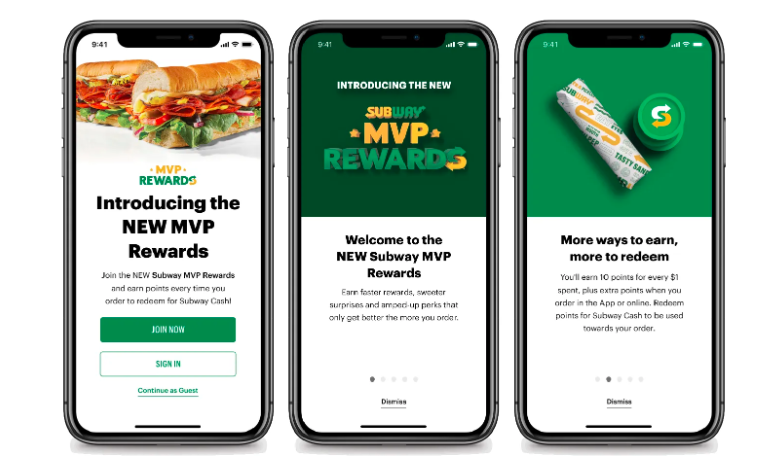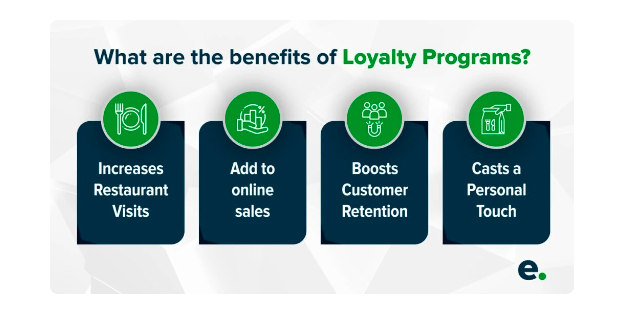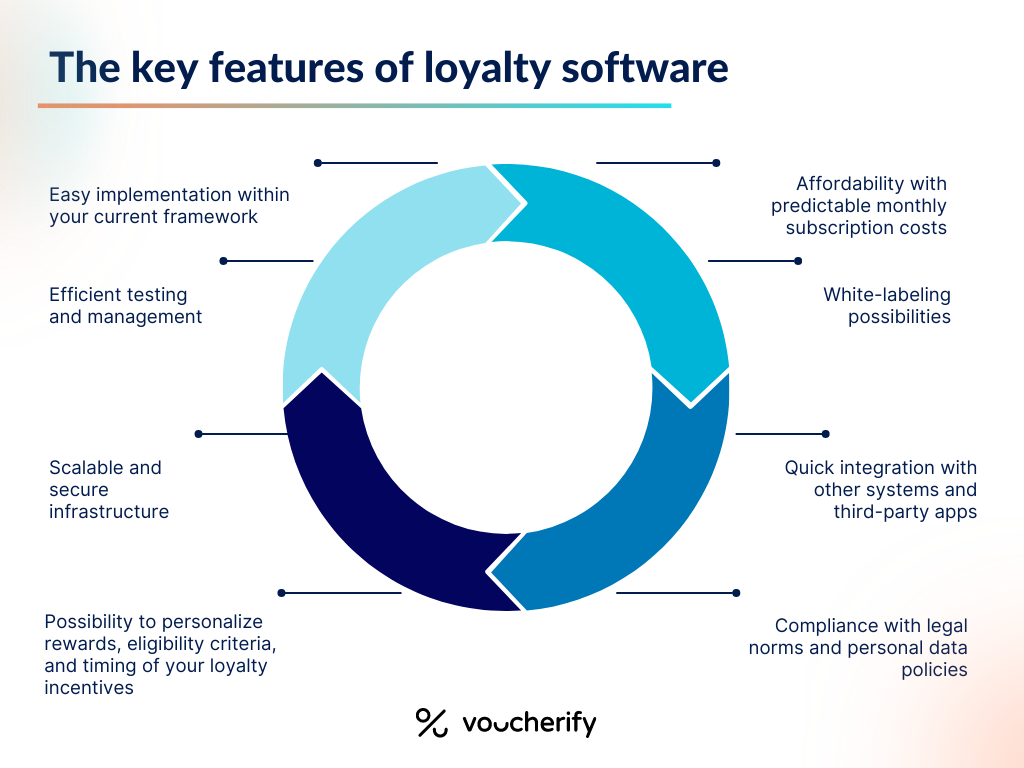- Solutions
-
-
Use Cases
-
-
-
- Our Resources
ARTICLES
- Blogs
- Case Studies
- Everything you need to know
DOWNLOADABLES
- eBooks & Whitepapers
- Videos
- Company
- Contact Us
- Request Demo
Use Cases
ARTICLES
DOWNLOADABLES
In the ever-competitive hospitality industry, attracting new customers is only half the battle; retaining them is just as crucial for long-term success.
Customer loyalty software is as a game-changing tool that can help restaurants build lasting relationships with their patrons.
Loyalty programs offer personalised rewards, tracking customer preferences, and providing valuable insights into dining habits. This software not only enhances the dining experience but also drives repeat business via additional rewards.

While attracting new customers is an achievement worth celebrating for any company, it’s just the beginning.
The real battle is the struggle to retain those customers and convert them into frequent diners. Customer retention is crucial for several reasons:
Customer loyalty software is a powerful tool to the challenge of customer retention and developing loyal consumers.
This technology leverages data and automation to create personalised, engaging experiences that keep customers coming back out of brand loyalty.
Here’s how customer loyalty software can transform your restaurant:

By analysing purchase history and behavioural data, restaurants can offer rewards that resonate with each customer and cater to individual customer preferences.
Loyalty software allows restaurants to offer exclusive promotions and deals to their most loyal customers. These promotions could include early access to new menu items, invitations to special events, birthday surprises, a free product, or limited-time discounts.
Exclusive deals not only encourage repeat visits but also a sense of exclusivity and privilege among loyal customers, making them feel special and appreciated.
Whether through a points system, punch cards, or tiered membership levels, rewards programs provide incentives for customers to continue choosing your restaurant over its competitors.
A well-executed loyalty program demonstrates that the restaurant values and appreciates its customers. By consistently recognising and rewarding loyalty, restaurants can build strong emotional connections with their customers.
Customer loyalty software provides valuable data on customer preferences, behaviours, and spending patterns. This data can be collected through various touchpoints, such as purchase history, feedback forms, and loyalty program interactions.
By analysing this data, restaurants can gain a deeper understanding of what drives customer satisfaction and tailor their offerings accordingly.
With detailed insights into customer preferences and behaviours, restaurants can create highly targeted marketing campaigns and relevant push notifications.
Targeted marketing campaigns are more likely to resonate with customers and drive higher engagement and conversion rates.
Loyalty programs can encourage customers to spend more per visit by offering targeted promotions and opportunities to earn rewards.
Additionally, tailored upsell suggestions based on past purchases can boost average order values.
By nurturing long-term loyalty, these programs can help build a stable and consistent revenue stream. Loyal customers are more likely to visit regularly, spend more, and refer others to the restaurant.
This steady patronage not only contributes to immediate revenue but also helps create a reliable customer base that can sustain the restaurant through fluctuations in the market.

A user-friendly interface is vital for successfully adopting customer loyalty software.
The software should be intuitive and straightforward, allowing staff to quickly learn and use it without extensive training. For customers, the enrollment process and participation in the loyalty program should be seamless and easy to navigate.
Integration
Ideally, customer loyalty software should integrate seamlessly with the restaurant’s existing POS systems and other technologies.
This integration allows for smooth data flow between systems, ensuring that loyalty points are accurately tracked, rewards are correctly applied, and customer data is consistently updated.
Compatibility with other technologies, such as payment processors and reservation systems, would further improve the functionality and efficiency of your loyalty program.
An effective loyalty program offers flexibility in the types of rewards that can be provided to customers.
Options can include points for each purchase, discounts on future visits, a free dessert, or exclusive access to special events. This flexibility allows restaurants to tailor their reward offerings to align with their brand, customer preferences, and marketing goals.
Tiered loyalty programs add an element of gamification and motivation for customers.
By offering different levels of rewards based on the customer’s loyalty and engagement, restaurants can encourage increased participation. This structure not only incentivises repeat business but also makes customers feel valued as they progress through the tiers.
Real-time data and analytics are essential for monitoring the success of a loyalty program and making informed decisions. The software should provide instant feedback on loyal consumers, such as purchase patterns, reward redemptions, and overall engagement.
This real-time insight allows restaurants to quickly identify trends, measure the effectiveness of promotions, and adjust their strategies to better meet customer needs.
Detailed reporting tools are a key feature of a rewards program.
These tools should generate comprehensive reports on various aspects of the loyalty scheme, including customer demographics, customer experience, reward usage, and overall program performance.
By analysing these reports, restaurants can refine their loyalty strategies, identify areas for improvement, and make data-driven decisions to enhance customer engagement and retention.
Mobile accessibility is a critical feature in today’s digital age. Effective customer loyalty software should offer a dedicated mobile app that provides a seamless and convenient experience for customers.
Through the app, customers can easily track their rewards, receive personalised offers, and stay informed about special promotions.
The app should also facilitate easy enrollment and participation in the loyalty program, enhancing customer convenience and engagement.
Integration with digital wallets and payment systems further enhances the convenience of customer loyalty software. Customers should be able to link their loyalty accounts with digital payment methods for online ordering, allowing for easy reward redemption and seamless transactions.
This integration not only simplifies the customer experience but also encourages more frequent use of the loyalty program, driving increased engagement and retention.

When selecting customer loyalty software, remember evaluate various options based on your specific needs and goals. Create a checklist of must-have features such as ease of use, customisation options, integration capabilities, and data analytics.
Compare different software solutions to see which ones offer the best combination of features that align with your restaurant’s requirements. Consider how each software handles reward management, customer engagement, frequent diners, and reporting to ensure it meets your operational needs.
The reputation and reliability of the software vendor are crucial factors to consider.
Research potential vendors to understand their track record in the industry. Look for customer reviews, case studies, and testimonials to gauge their performance and reliability.
Additionally, consider the level of support and training they offer. A vendor that provides robust support services, including onboarding assistance and ongoing technical support, can significantly enhance the implementation process and long-term success of the software.
Adequate staff training is essential to ensure the successful implementation of customer loyalty software. Provide comprehensive training sessions to ensure all team members understand how to use the software effectively.
Training should cover all aspects of the software, from enrolling customers and managing rewards to generating reports and troubleshooting issues.
Promoting your loyalty program within the restaurant is essential for attracting customer participation. Use eye-catching signage, such as posters, table tents, and digital displays, to inform customers about the program and its benefits.
Ensure that staff members actively promote the program during customer interactions, such as at the point of sale, during table service, or while customers wait.
Use social media platforms to share updates, success stories, and special promotions related to the loyalty program.
Email newsletters can keep your existing customers informed and engaged with exclusive offers and reminders to join the program.
Ensure that your website prominently features information about the loyalty program, including how to sign up and the benefits of participation. Consider creating a dedicated landing page that provides detailed information and a signup form.
Regular monitoring and evaluation of your loyalty program is essential for its long-term success.
Use the data and analytics provided by your loyalty software to track key performance indicators (KPIs) such as enrollment rates, spend, reward redemption, and customer retention, for example.
Regularly review these metrics to identify trends and areas for improvement. Make necessary adjustments to the program based on your findings, such as modifying rewards, updating marketing strategies, or addressing any operational challenges.
Customer feedback is invaluable for refining and enhancing your loyalty program. Encourage customers to provide feedback through surveys, suggestion boxes, or direct communication with staff.
Actively listen to their suggestions and concerns, and use this feedback to make improvements to the program. Regularly communicating changes and updates to customers based on their feedback can demonstrate that you value their input and are committed to providing the best possible experience.
Introducing customer loyalty programs to your restaurant is a strategic move that can dramatically improve customer engagement, retention, and overall revenue.
In this increasingly competitive space, fostering long-term relationships with customers is more crucial than ever. By leveraging the power of personalised rewards, gaining valuable customer insights, and using data-driven marketing, your restaurant can create a compelling loyalty program that keeps customers coming back.
Choosing the right loyalty software, ensuring ease of use, and integrating it seamlessly with your existing systems are foundational steps.
Proper training for staff and effective promotion of the program both in-restaurant and through digital channels are key to driving customer participation and maximising the program’s impact.
Regularly monitoring performance and incorporating customer feedback will help you continuously refine and improve your loyalty program, ensuring it remains relevant and effective.
By investing in customer loyalty software and committing to its successful implementation, your restaurant can build a loyal customer base, increase repeat visits, and create a stable revenue stream.